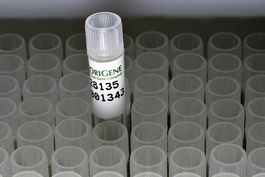Selenophosphate synthetase 2 (SEPHS2) (NM_012248) Human Tagged ORF Clone
CAT#: RC201830L4
- LentiORF®
Lenti-ORF, SEPHS2 (mGFP-tagged) - Human selenophosphate synthetase 2 (SEPHS2), (Note: selenocystein protein, Internal stop codon present. See Summary below)
"NM_012248" in other vectors (7)
Product Images

Specifications
| Product Data | |
| Type | Human Tagged ORF Clone |
| Tag | mGFP |
| Symbol | SEPHS2 |
| Synonyms | SPS2 |
| Vector | pLenti-C-mGFP-P2A-Puro |
| E. coli Selection | Chloramphenicol (34 ug/mL) |
| Mammalian Cell Selection | Puromycin |
| Sequence Data |
The ORF insert of this clone is exactly the same as(RC201830).
|
| Restriction Sites | SgfI-MluI Cloning Scheme for this gene |
| ACCN | NM_012248 |
| OTI Disclaimer | The molecular sequence of this clone aligns with the gene accession number as a point of reference only. However, individual transcript sequences of the same gene can differ through naturally occurring variations (e.g. polymorphisms), each with its own valid existence. This clone is substantially in agreement with the reference, but a complete review of all prevailing variants is recommended prior to use. More info The expression of this clone is not guaranteed due to the nature of selenoproteins. |
| OTI Annotation | This clone encodes a selenoprotein containing the rare amino acid selenocysteine (Sec). Sec is encoded by UGA codon, which normally signals translational termination. Expression of this clone is not guaranteed due to the nature of selenoproteins. |
| Reference Data | |
| RefSeq | NM_012248.2, NP_036380.2 |
| RefSeq Size | 2351 |
| RefSeq ORF | 1347 |
| Locus ID | 22928 |
| Domains | AIRS |
| Protein Pathways | Metabolic pathways, Selenoamino acid metabolism |
| Gene Summary | This gene encodes an enzyme that catalyzes the production of monoselenophosphate (MSP) from selenide and ATP. MSP is the selenium donor required for synthesis of selenocysteine (Sec), which is co-translationally incorporated into selenoproteins at in-frame UGA codons that normally signal translation termination. The 3' UTRs of selenoprotein mRNAs contain a conserved stem-loop structure, the Sec insertion sequence (SECIS) element, which is necessary for the recognition of UGA as a Sec codon rather than as a stop signal. This protein is itself a selenoprotein containing a Sec residue at its active site, suggesting the existence of an autoregulatory mechanism. It is preferentially expressed in tissues implicated in the synthesis of selenoproteins and in sites of blood cell development. A pseudogene for this locus has been identified on chromosome 5. [provided by RefSeq, May 2017] |
Documents
| Product Manuals |
| FAQs |
| SDS |
Resources
Other Versions
| SKU | Description | Size | Price |
|---|---|---|---|
| SC115458 | SEPHS2 (untagged)-Human selenophosphate synthetase 2 (SEPHS2) (10ug), (Note: selenocysteine protein, Internal stop codon present. see reference data summary below) |
USD 310.00 |
|
| SC320578 | SEPHS2 (untagged)-Human selenophosphate synthetase 2 (SEPHS2) (10ug), (Note: selenocysteine protein, Internal stop codon present. see reference data summary below) |
USD 310.00 |
|
| RC201830 | SEPHS2 (Myc-DDK-tagged)-Human selenophosphate synthetase 2 (SEPHS2), (Note, selenocysteine protein, internal stop codon, see reference data summary) |
USD 420.00 |
|
| RG201830 | SEPHS2 (GFP-tagged) - Human selenophosphate synthetase 2 (SEPHS2), (10ug), (Note: selenocysteine protein, Internal stop codon present. see reference data summary below) |
USD 460.00 |
|
| RC201830L1 | Lenti-ORF, SEPHS2 (Myc-DDK-tagged)-Human selenophosphate synthetase 2 (SEPHS2), (Note, selenocystein protein, internal stop codon, see summary) |
USD 620.00 |
|
| RC201830L2 | Lenti-ORF, SEPHS2 (mGFP-tagged) - Human selenophosphate synthetase 2 (SEPHS2), (Note: selenocystein protein, Internal stop codon present. See Summary below) |
USD 620.00 |
|
| RC201830L3 | Lenti-ORF, SEPHS2 (Myc-DDK-tagged)-Human selenophosphate synthetase 2 (SEPHS2), (Note, selenocystein protein, internal stop codon, see summary) |
USD 620.00 |
{0} Product Review(s)
Be the first one to submit a review






























































































































































































































































 Germany
Germany
 Japan
Japan
 United Kingdom
United Kingdom
 China
China
